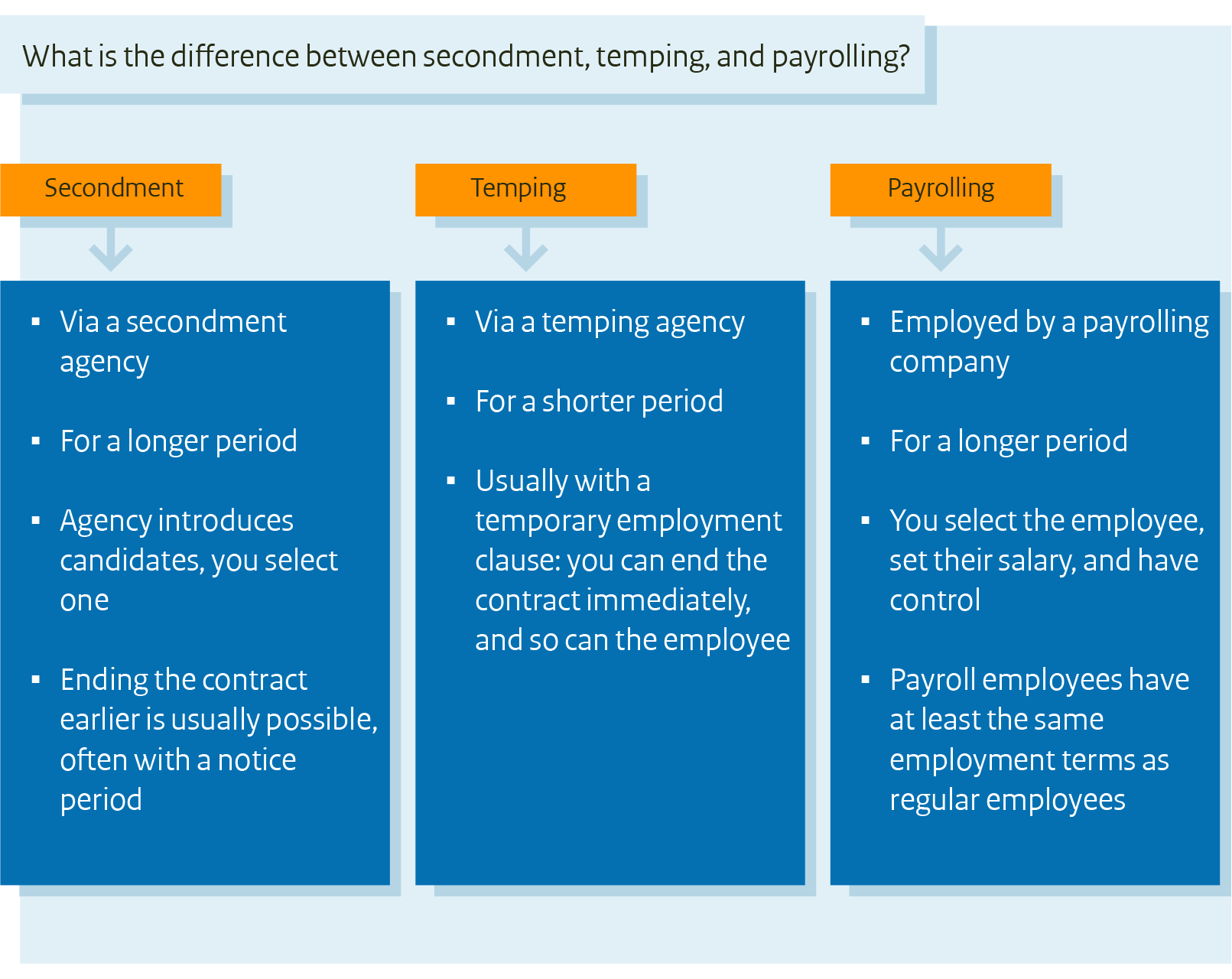Hiring an employee through secondment

If you want to hire someone temporarily, you can 'borrow' an employee from another company. That company seconds or lends the employee to you. As the 'hirer', you must comply with the rules in the Workers Allocation by Intermediaries Act (Waadi).
What is secondment?
With secondment (detachering), an employee temporarily works for another company. The employee remains an employee of the company hiring them out.
How does secondment work?
Secondment involves 3 parties:
1. Lender
The lender is the employer. They second (lend, hire out, post) the employee and ensure the payment of wages. The lender is also called an intermediary. This can be, for example, a temporary employment agency (uitzendbureau) or a secondment agency (detacheringsbureau). Or a company that lends staff for payment.
2. Hirer
The hirer is the client: the company that hires an employee from the lender. For this, the hirer pays a fee to the lender.
3. Employee
Is in (permanent) employment of the lender and is temporarily lent to the hirer. Here, the employee works under the direction and supervision of the hirer.
Salary with secondment
The employee is on the lender's payroll. As the client, you determine the salary. This depends, for example, on the type of work and the necessary work experience of the employee. Take into account the fee you pay to the lender. This comes on top of the salary.
Rules for secondment
The Waadi act contains the rules for hiring and lending personnel.
The following rules apply to you as a hirer:
- You must check if the lender is registered in the KVK Business Register.
- You must ensure equal working conditions for all your employees (both hired and salaried).
- You may not replace employees on strike (stakingsbreking, in Dutch) with hired workers.
Use this checklist to quickly determine which obligations you must fulfil when hiring staff through an intermediary.
When do you opt for secondment?
Hiring an employee through secondment can be convenient for several reasons:
- You do not want to run any employer risks. Such as continued payment of wages in case of illness.
- You have a temporary need for extra help or knowledge within your company. For example, to cover an employee’s maternity leave or for a project.
Liability for payroll tax and turnover tax
The lender must pay payroll taxes for the employee you hire. If the lender fails to do so, the Tax Administration may hold you liable for this. The same goes for turnover tax (VAT) for the hired employee.
Read more about liability for payroll tax and turnover tax.
Hiring an employee from abroad via secondment
Do you want to hire an employee from abroad via an intermediary? If so, you will have to deal with additional rules besides the Waadi.
What is the difference between secondment, temping, and payrolling?
Secondment, temping, and payrolling are forms of flexible employment mediation for when you temporarily need extra staff. The main features at a glance:
- A secondment contract is often for a longer period. The 3 parties determine the end date and the average number of working hours per week in advance.
- A secondment contract may include a notice period. You can then terminate the contract with the lender at an earlier time. Does the secondment contract contain an agency clause (uitzendbeding)? If so, you can terminate the contract immediately.
- With secondment, you often get to decide which candidate comes to work for you. The secondment agency will introduce a number of its employees. Sometimes the secondment agency will recruit a new employee especially for your assignment. The secondment agency then hires this person to carry out the assignment with you.
- A temping contract is often for a short period and usually has an agency clause. This gives both you and the employee the opportunity to end the employment contract immediately, without giving a reason.
- All 3 parties can terminate the contract. In practice, either the hirer or the employee does this.
- The temporary employment agency usually decides who will work for you.
- In payrolling, you enter into a contract with a payroll company. You recruit the employee yourself, determine the salary, and have control over the employee. But the employee is employed by the payroll company.
- Payrollers have the same dismissal protection as employees employed directly by you. In case of possible dismissal of a payroll employee, the Employee Insurance Agency (Uitvoeringsinstituut Werknemersverzekeringen, UWV) or the court will assess the circumstances. You cannot then simply terminate the payroll contract.
- Payroll employees have at least the same employment conditions (in Dutch) as employees directly employed by you.
 tabel showing difference between secondment, temping and payrolling
tabel showing difference between secondment, temping and payrolling
Related articles
Questions relating to this article?
Please contact the Netherlands Chamber of Commerce, KVK